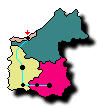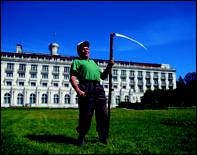|
Tour 2: Jurmala-Jelgava-Eleja-Pilsrundale-Bauska |
 Jurmala, known as a health resort since the 19th century, was founded
in 1959 with the uniting of the towns of Sloka, Kemeri and Jurmala;
today those names survive to mark the town's three railway stations.
Jurmala is easily reached by road from Riga, only 20 km away; you can
also reach it quickly and easily by electric train, minibus or taxi.
Today the town is a fascinating combination of traditional and modern
architecture: wooden summer houses complete with verandas and woodcuts
rub shoulders with modern resort buildings. Because of its history as
a popular destination for visitors, Jurmala abounds with fascinating
exhibitions, galleries and museums, all offering regular and varied
displays.
Jurmala, known as a health resort since the 19th century, was founded
in 1959 with the uniting of the towns of Sloka, Kemeri and Jurmala;
today those names survive to mark the town's three railway stations.
Jurmala is easily reached by road from Riga, only 20 km away; you can
also reach it quickly and easily by electric train, minibus or taxi.
Today the town is a fascinating combination of traditional and modern
architecture: wooden summer houses complete with verandas and woodcuts
rub shoulders with modern resort buildings. Because of its history as
a popular destination for visitors, Jurmala abounds with fascinating
exhibitions, galleries and museums, all offering regular and varied
displays.
 South of Jurmala, straddling the Lielupe river by the Zemgale plains,
is Jelgava, a major industrial centre and a key junction for several
railway lines and main roads, including the road to ęiauliai, in
Lithuania. That doesn't mean you should just pass through: Jelgava
is home to the Baltics' most spectacular baroque palace, built under
the supervision of B.F. Rastrelli between 1737 and 1769, as well as
the Latvian Agricultural University. In 1825 the Tomb of the Duke of
Courland, containing 21 metal sarcophagi (the oldest dating from
1569), and nine coffins were installed here. More can be learnt from
the town's History and Art Museum at 10 Akadeijas Street, a baroque
building with the classic features of the former Academia Petrina
(1773-1775). Driving to Pilsrundale after 25 km you'll pass through
the Eleja collection of estates in the middle of some spectacular
parkland before arriving at Pilsrundale (Rundale Palace) 18 km away
and close to the Lithuanian border. Built by B.F. Rastrelli between
1736 and 1740, it is the most complete collection of baroque
buildings in Latvia, and was the summer residence of the Duke of
Courland, E.J. Biron. Today it houses the Rundale Museum, which
has mounted a permanent exhibition on the ground floor. The Golden
Hall on the first floor is the most splendid room in the palace,
and in the China Cabinet there are some exquisite Chinese and
Japanese vases. The White Hall, the palace's ballroom, is stunning
and there are several other interesting rooms. To the east of
Pilsrundale in the south-eastern section of the Zemgale plain is
Bauska, built where the Memele and Musa rivers join to from the
Lielupe. On the hill between the two rivers lie the remains of a
Livonian Castle; the partially intact main tower, 22 m high,
provides marvellous views. The Bauska Regional Study and Art Museum
at 6 Kalna Street provides you with more detail on the town.
South of Jurmala, straddling the Lielupe river by the Zemgale plains,
is Jelgava, a major industrial centre and a key junction for several
railway lines and main roads, including the road to ęiauliai, in
Lithuania. That doesn't mean you should just pass through: Jelgava
is home to the Baltics' most spectacular baroque palace, built under
the supervision of B.F. Rastrelli between 1737 and 1769, as well as
the Latvian Agricultural University. In 1825 the Tomb of the Duke of
Courland, containing 21 metal sarcophagi (the oldest dating from
1569), and nine coffins were installed here. More can be learnt from
the town's History and Art Museum at 10 Akadeijas Street, a baroque
building with the classic features of the former Academia Petrina
(1773-1775). Driving to Pilsrundale after 25 km you'll pass through
the Eleja collection of estates in the middle of some spectacular
parkland before arriving at Pilsrundale (Rundale Palace) 18 km away
and close to the Lithuanian border. Built by B.F. Rastrelli between
1736 and 1740, it is the most complete collection of baroque
buildings in Latvia, and was the summer residence of the Duke of
Courland, E.J. Biron. Today it houses the Rundale Museum, which
has mounted a permanent exhibition on the ground floor. The Golden
Hall on the first floor is the most splendid room in the palace,
and in the China Cabinet there are some exquisite Chinese and
Japanese vases. The White Hall, the palace's ballroom, is stunning
and there are several other interesting rooms. To the east of
Pilsrundale in the south-eastern section of the Zemgale plain is
Bauska, built where the Memele and Musa rivers join to from the
Lielupe. On the hill between the two rivers lie the remains of a
Livonian Castle; the partially intact main tower, 22 m high,
provides marvellous views. The Bauska Regional Study and Art Museum
at 6 Kalna Street provides you with more detail on the town.
|


